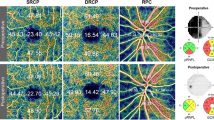Abstract
Purpose
To evaluate the relationship between macular ganglion cell complex (GCC) parameters and visual field (VF) parameters in chiasmal compression and the potential for GCC parameters in order to predict the short-term post-surgical VF.
Methods
Twenty-three eyes of 12 patients with chiasmal compression and 33 control eyes were studied. All patients underwent transsphenoidal tumor resection. Before surgery a 3D scan of the macula was taken using spectral-domain optical coherence tomography. All patients underwent Humphrey 24-2 VF testing after surgery. Spearman’s rank correlation coefficients were used to evaluate the relationship between the GCC parameters and VF parameters [mean deviation (MD), pattern standard deviation]. Coefficients of determination (R 2) were calculated using linear regression.
Results
Average thickness in the patients was significantly thinner than that of controls. Average thickness, global loss volume and focal loss volume (FLV) significantly correlated with the MD. We observed the greatest R 2 between FLV and MD.
Conclusions
Examining the macular GCC was useful for evaluating structural damage in patients with chiasmal compression. Preoperative GCC parameters, especially FLV, may be useful in predicting visual function following surgical decompression of chiasmal compression.




Similar content being viewed by others
References
Monteiro ML, Leal BC, Rosa AA, Bronstein MD. Optical coherence tomography analysis of axonal loss in band atrophy of the optic nerve. Br J Ophthalmol. 2004;88:896–9.
Kanamori A, Nakamura M, Matsui N, Nagai A, Nakanishi Y, Kusuhara S, et al. Optical coherence tomography detects characteristic retinal nerve fiber layer thickness corresponding to band atrophy of the optic discs. Ophthalmology. 2004;111:2278–83.
Moura FC, Medeiros FA, Monteiro ML. Evaluation of macular thickness measurements for detection of band atrophy of the optic nerve using optical coherence tomography. Ophthalmology. 2007;114:175–81.
Costa-Cunha LV, Cunha LP, Malta RF, Monteiro ML. Comparison of Fourier-domain and time-domain optical coherence tomography in the detection of band atrophy of the optic nerve. Am J Ophthalmol. 2009;147:56–63.
Monterio ML, Costa-Cunha LV, Cunha LP, Malta RF. Correlation between macular and retinal nerve fibre layer Fourier-domain OCT measurements and visual field loss in chiasmal compression. Eye. 2010;24:1382–90.
Danesh-Meyer HV, Carroll SC, Foroozan R, Savino PJ, Fan J, Jiang Y, et al. Relationship between retinal nerve fiber layer and visual field sensitivity as measured by optical coherence tomography in chiasmal compression. Invest Ophthalmol Vis Sci. 2006;47:4827–35.
Monteiro ML, Cunha LP, Costa-Cunha LV, Maia OO Jr, Oyamada MK. Relationship between optical coherence tomography, pattern electroretinogram and automated perimetry in eyes with temporal hemianopia from chiasmal compression. Invest Ophthalmol Vis Sci. 2009;50:3535–41.
Johansson C, Lindblom B. The role of optical coherence tomography in the detection of pituitary adenoma. Acta Ophthalmol. 2009;87:776–9.
Tan O, Chopra V, Lu AT, Schuman JS, Ishikawa H, Wollstein G, et al. Detection of macular ganglion cell loss in glaucoma by Fourier-domain optical coherence tomography. Ophthalmology. 2009;116:2305–14.
Danesh-Meyer HV, Papchenko T, Savino PJ, Law A, Evans J, Gamble GD. In vivo retinal nerve fiber layer thickness measured by optical coherence tomography predicts visual recovery after surgery for parachiasmal tumors. Invest Ophthalmol Vis Sci. 2008;49:1879–85.
Jacob M, Raverot G, Jouanneau E, Borson-Chazot F, Perrin G, Rabilloud M, et al. Predicting visual outcome after treatment of pituitary adenomas with optical coherence tomography. Am J Ophthalmol. 2009;147:64–70.
Wall M, Punke SG, Stickney TL, Brito CF, Withrow KR, Kardon RH. SITA standard in optic neuropathies and hemianopias: a comparison with full threshold testing. Invest Ophthalmol Vis Sci. 2001;42:528–37.
Huang D, Tan O. Introduction to RTVue for glaucoma diagnosis. In: Weinreb RN, Varma R, editors. RTVue Fourier-domain optical coherence tomography primer series, vol. III. Glaucoma. Fremont: Optovue, Inc; 2009. p. 3–18.
Monterio ML, Moura FC, Medeiros FA. Diagnostic ability of optical coherence tomography with a normative database to detect band atrophy of the optic nerve. Am J Ophthalmol. 2007;143:896–9.
Gnanalingham KK, Bhattacharjee S, Pennington R, Ng J, Mendoza N. The time course of visual field recovery following transsphenoidal surgery for pituitary adenomas: predictive factors for a good outcome. J Neurol Neurosurg Psychiatry. 2005;76:415–9.
Rüther K, Ehlich P, Philipp A, Eckstein A, Zrenner E. Prognostic value of the pattern electroretinogram in cases of tumors affecting the optic pathway. Graefes Arch Clin Exp Ophthalmol. 1998;236:259–63.
Parmar DN, Sofat A, Bowman R, Bartlett JR, Holder GE. Visual prognostic value of the pattern electroretinogram in chiasmal compression. Br J Ophthalmol. 2000;84:1024–6.
Ventura LM, Venzara FX 3rd, Porciatti V. Reversible dysfunction of retinal ganglion cells in non-secreting pituitary tumors. Doc Ophthalmol. 2009;118:155–62.
Kayan A, Earl CJ. Compressive lesions of the optic nerves and chiasm. Pattern of recovery of vision following surgical treatment. Brain. 1975;98:13–28.
Unsöld R, Hoyt WF. Band atrophy of the optic nerve. The histology of temporal hemianopsia. Arch Ophthalmol. 1980;98:1637–8.
Acknowledgments
We thank JAM Post editing for this manuscript.
Conflict of interest
The authors have no proprietary interests in any of the material used in this study.
Author information
Authors and Affiliations
Corresponding author
About this article
Cite this article
Ohkubo, S., Higashide, T., Takeda, H. et al. Relationship between macular ganglion cell complex parameters and visual field parameters after tumor resection in chiasmal compression. Jpn J Ophthalmol 56, 68–75 (2012). https://doi.org/10.1007/s10384-011-0093-4
Received:
Accepted:
Published:
Issue Date:
DOI: https://doi.org/10.1007/s10384-011-0093-4




